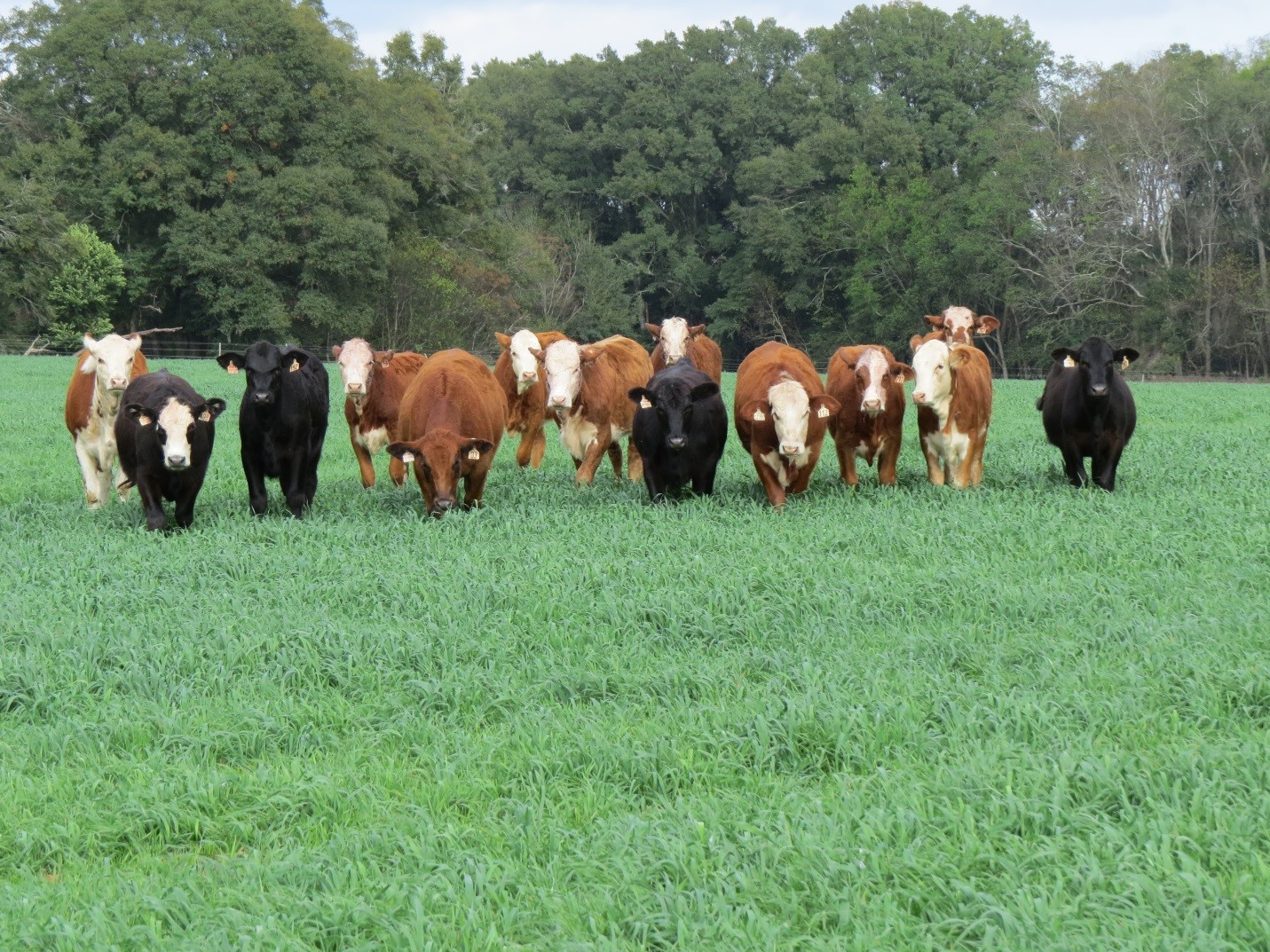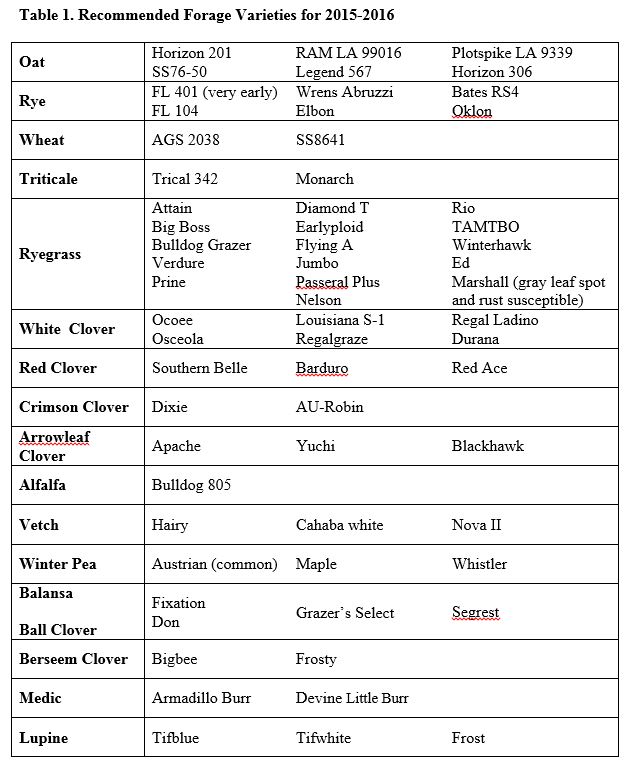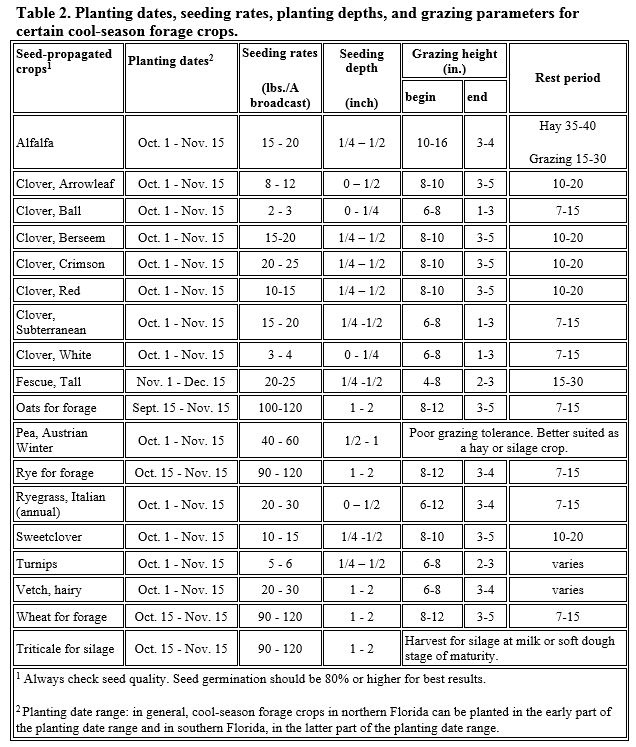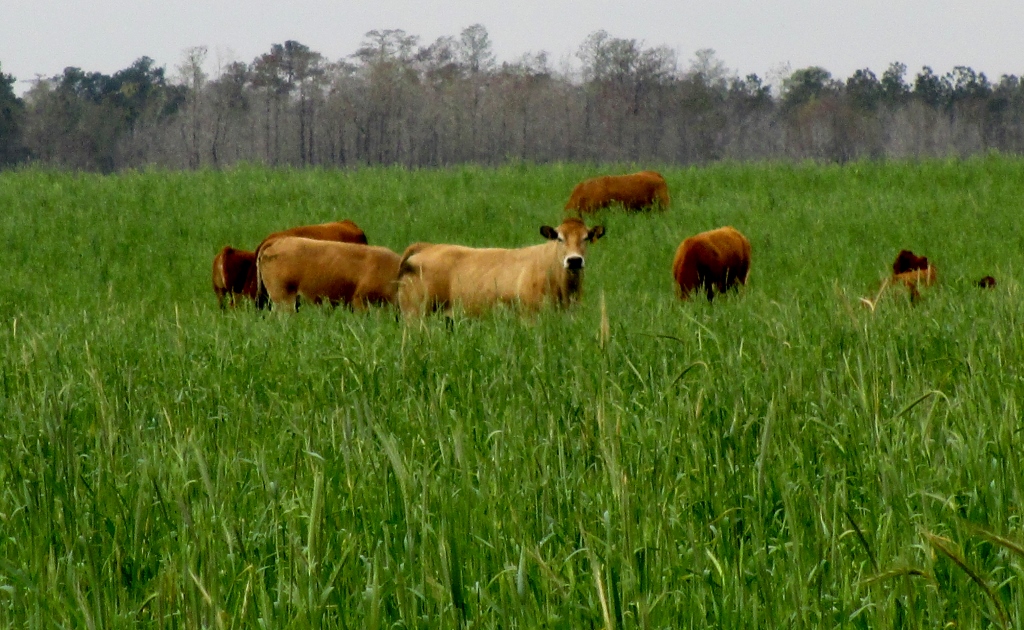
Ann Blount, Patricio Munoz, Jose Dubeux, Joao Vendramini, Ali Babar, Kevin Kenworthy, and Ken Quesenberry (North Florida Research and Education Center, Department of Agronomy, and the Range Cattle Research and Education Center)
The 2015 cool-season forage line-up is ready to share with our Florida forage producers. An abundance of rain last spring caused significant problems with seed set and grain harvest for cereal rye, triticale and oat that were locally grown. Cereal rye and triticale, in particular, may be in short supply this planting season. At the present time, only Tricale 342 and Monarch triticale are recommended. Last year we tested several triticale varieties sold in the state that were not adapted to Florida and they were not productive.
The oat crop was somewhat hampered, but there should be an adequate seed supply on the market If rye or triticale seed is unavailable, oat will be a viable substitute. Remember that there is a new strain of crown rust that attacks most of our eastern oat varieties. A later planting date and grazing should minimize the problem, or consider combining oats with ryegrass in a mixture to spread the risk. The new crown rust resistant Legend 567 will be on the market this fall and seed for RAM Oat (LA99016), Horizon 201 and Horizon 306 should be available. If oat is grown for silage or seed, be prepared to spray with a legal fungicide to protect the crop from a crown rust outbreak.
Seed of ryegrass, clovers, vetch and winterpeas should be in plentiful supply. However, we suggest that operations depending on planting cool-season forages request their needs quickly to secure their seed so as to have it available at planting time.
As in most years, moisture is the key to successful fall forage plantings. Our current predictions are for sufficient rainfall during our fall planting window, which generally starts in mid-September through mid-November.
Recommended varieties for planting this fall are listed in Table 1. While there may be other suitable varieties, our recommendations are based on multi-location, multi-year testing under our Florida growing conditions.

We suggest a seeding rate of 90 to 120 lbs per acre for all small grains. If planting a mixture, you should adjust the seeding rate for each component to half of the recommended rate. If you plant late in the season, use the higher end of the recommended seeding rates for each forage. Additional information to help you with seeding rates, planting depth and grazing or hay recommendations are found in Table 2.
Other things to consider:
- If pastures are not irrigated there is risk involved with planting cool-season forages. Conserved forage or supplements may be the better option.
- If you do plant winter grazing on non-irrigated land, remember that small grains are more drought tolerant than ryegrass.
- When planting ryegrass either in a mixture with small grains or alone, plant on wetter sites. Ryegrass needs good moisture for establishment and growth.
- Vetch and winter peas are fairly drought tolerant. Clovers, however, prefer good moisture for germination and establishment. There is some variation in site suitability for clovers. While, white clovers prefer wetter sites, crimson, red, arrowleaf, and ball are more tolerant of well-drained soils
If you should have questions about planting cool-season forages please contact your local UF-IFAS county agent. An updated and complete version of the 2015-2016 Cool-Season Forage Variety Recommendations will be available on-line shortly at http://edis.ifas.ufl.edu
Download a printer friendly PDF version of this article:
2015 Fall Forage Update
 For more information related to this article:
For more information related to this article:
Cool Season Forage Planting Decisions
Alabama Planting Guide for Forage Grasses ANR-0149
Alabama Planting Guide for Forage Legumes ANR-0150
UGA Georgia Forages: Grass Species
UGA Georgia Forages: Legume Species
 0
0


Comments:
May 17, 2016
You or your Master Gardener Coordinator can contact the author of the article Gary Knox at the NFREC for possible tour information.
May 13, 2016
Hi--my name is Pat Watkins and I am a master gardener in Columbia County, FL. I am trying to put together field trips for my group and wonder where I can find info about the Gardens of the Big Bend. If field trips/group tours are not available, then I am personally interested in the Magnolia Gardens. Where can I find out about that, please?
April 21, 2016
One of my favorites! Nice article - we enjoyed speaking with the Gardening Friends last week and glad we had time to walk through the garden first. Keep up the good work! Thanks Donna
April 19, 2016
Dear Joe: I work with tomato in Brazil, west part of S.Paulo State, and so far TSWV in one of most important virus disease in my area. This article is very important, because I can now be more confident that there is a new strain (TSCV) of tospovirus also occurring in my field. Hopefully TSWV tolerant hybrid tomato could be also be tolerant to this new strain TSCV. Vanderlei Barbosa (Agronomist, tomato grower)
April 1, 2016
Good Morning Dr. Ober - Do you have any information on building bat boxes? We would like to build some to put down by our pond on our property - Thanks, Donna D
January 25, 2016
Yes I think these numbers are set by the Ag Census and are not completely accurate.
January 22, 2016
Would love to have our 6 acres of Blueberries in Jackson County. Mary Veitch Veitch's Blueberry Farm 7772 Howell Rd Sneads, FL 32460
November 16, 2015
Is there a soil fumigant that works on Sclerotium rolfsii fungus? We have a home garden and have rotated crops but are running out of options.
November 16, 2015
Follow the links in this article and go to the App store that applies to your smart phone. If you don't have a smart phone, you can get similar information on the following website: http://www.iowabeefcenter.org/estrus_synch.html
November 16, 2015
Follow the links in this article and go to the App store that applies to your smart phone. If you don't have a smart phone, you can get similar information on the following website: http://www.iowabeefcenter.org/estrus_synch.html
November 14, 2015
I would like to receive the AI cow calculator
October 27, 2015
It is a relatively new byproduct but our first estimates based on digestibility and nutrient analyses indicate that the TDN of B. carinata meal should be around 70-75% TDN.
October 6, 2015
What is the average TDN value for carinata meal?
August 30, 2015
Have you tried fixation clover ? I am thinking about in north Jefferson county
June 27, 2015
I would like to receive the calculator
June 24, 2015
Thanks for your comment! The Black Diamond series of crapemyrtles have been planted at the UF North Florida Research and Education Center (outside Tallahassee). An older, outstanding planting can be found at the Louisiana State University Hammond Research Center, if you happen to be traveling along I-10 in Louisiana.
June 24, 2015
I found this article most timely as I just purchased my first crape myrtle ever. It is the black diamond series with red blooms. I can't wait to see how well this performs here. I hope eventually to plant it in my yard also at my home in Brevard county(Melbourne) also. Are there any evaluations ongoing for this new black diamond? It's the first crape myrtle ever that I liked well enough to plant. Thanks!!!!!
June 23, 2015
Hi Gary, I was just reading the crapemyrtle article and then looked at the bottom to see it was by Gary Knox. Marilyn (Bennett) Akers and I live in Elberta, AL (near Pensacola) six months a year. We've planted several crapemyrtle at our home there. I retired from Purdue Extension 2 summers ago. In case you don't remember, Marilyn was Phil Carpenter's grad student. She say hi! I got a Master's in Botany & Plant Pathology. I was Purdue Extension Educator, Ag & Natural Resources for 30 years. All in Boone County, (Lebanon) less than an hour from W. Lafayette. We still have our home in Lebanon, too. Doug Akers
February 6, 2015
Excellent, and to the well trained ear, this article may well be the best introduction to profitable grazing for all ranchers, and not just for cattlemen. "Adjusting the stocking rate...is the most important grazing management tool to improve forage utilization." Well said, but rotational grazing only marginally adjusts the stocking rate and still allows the animals to pick and choose what they eat, taking the best and leaving the worst--thereby affirming that animals don't make good business decisions. Adjusting the stocking density (not rate) using management intensive grazing whereby one restricts the amount of available forage insures the animals consume only an amount of forage required to meet their demands for the day and are then released the next day into a new paddock (subunit). The amount of acreage provided daily can easily be estimated while considering all the factors listed above. The key is inexpensive temporary electric fencing and a good eye for growth rate. For those willing to follow the successful and disregard the "That won't fly around here Sonny"-mentality, I'd point you to "Management-Intensive Grazing: The Grassroots of Grass Farming" by Jim Gerrish; or visit http://www.americangrazinglands.com/
February 6, 2015
Take a look at this link for info on Crapemyrtle Pruning. http://edis.ifas.ufl.edu/ep399 Thanks, Matt
February 6, 2015
What level of pruning is appropriate for a Crepe Mytle? Is there any or should I just let it grow? Thanks! Phil
February 6, 2015
We don't have a button yet..... Just copy and then paste the URL on your facebook page and post it...this will achieve the same effect.
February 4, 2015
I looked for a Facebook "Share" button.
December 22, 2014
please send me a catalog on you January 17 2015 florida bull test sale. Kenneth avery 2993 county road 67 Hartford Alabama 36344.
December 5, 2014
Finally! Would you be able to supply me a list of sellers of trees that are the most scab resistant? I believe now would be a good time to plant a few. Regards, Tom
August 4, 2014
I wrote an article few weeks ago on that very topic. Check out this article: http://nwdistrict.ifas.ufl.edu/phag/2014/07/18/tips-for-controlling-armyworms-in-hay-fields/
August 1, 2014
Other than cutting my hay field, what can be done when army worms are found ? Is there any preventive measure that can be taken to help prevent army worms ? Will adding sulfur to my fertilizer help prevent army worms ? If so how many pounds to the acre ? What can be sprayed to kill army worms ?
July 19, 2014
Is there any Balansa Clover seed available for sale to the public? I would love to try some on my farm. Hope I can get over and see all the projects you all have going on. Tim Tucker Uriah AL.
July 16, 2014
I adore pomegranate fruit and shrubs, so I was especially thrilled to learn of this new variety. However, I’m not sure how I feel about one that doesn't produce edible fruit . I've had a pomegranate in my greenhouse for several years, and although it doesn't produce much fruit, it’s always a beautiful, flowering plant. I’d recommend them to anyone. As to fruit, I think the Wonderful variety (as its name implies), is simply wonderful and the most delicious variety I've tried. Richard
May 30, 2014
Hello Peter, My wife and I are new at planting trees. We have 20 acres in North Walton County and the pH is 5.7. Please correct me if I am wrong, but it looks like the fuyu species is the best all-around fruit. We are looking at planting 5-10 trees. In addition to applying fertilizer as you discussed, should we address the pH level as well? Can we obtain the trees through the extension office? If not, can you recommend a source where they are available? We are open to any suggestions you may have. Thank you in advance for your help- Brett
January 12, 2014
sir, can i have more information on above two newly introduced variety of peanuts? if so i will be thankfull to you, I from India guajrat state and we are the farmers and maily cultiviting peanuts on our farms, here is production is around 1ooo kg per acre i.e. 2500 kg per hectare, so please let me know about new variety Thanks
January 10, 2014
The sort of trimming known as "crape murder" will not ensure the long term health of the crapemyrtle. Those repetitive cuts will allow disease and rot to enter the tree. Older cultivars might be in too much shade and not blooming to their full potential. They may also be suffering from powdery mildew, scale or sooty mold. Thinning of the interior of the tree may help. See this publication on crapemyrtle pruning for more information.
January 8, 2014
I love crepe myrtles of any kind. I guess it reminiscent of my grandmother's gardens. In southwest Florida she never cut back our crepe myrtles and they were more like the last photo in bloom. However, here in the Panhandle everyone does what I my sister and I call crepe murder, cutting the trees back. I want to know what is really appropriate. I've always said this was improper, but I notice that the trees that are cut this way to appear more healthy and vibrant each spring. I've moved to a home that has several varieties and the older ones are not doing well (blooming profusely) but I'm afraid it's because I have refused to cut the trees, I just trimmed them a little. Thanks for your help.
September 15, 2013
Dr. Anderson was talking about the gradual cooling that occurs normally in Northwest Florida. More damage occurs with extreme temperature changes, like can often happen in South Florida.
September 14, 2013
What is meant by cold pre-conditioned trees in your article above? Is that something that nature does, or something that the grower can do?
Comments are closed.